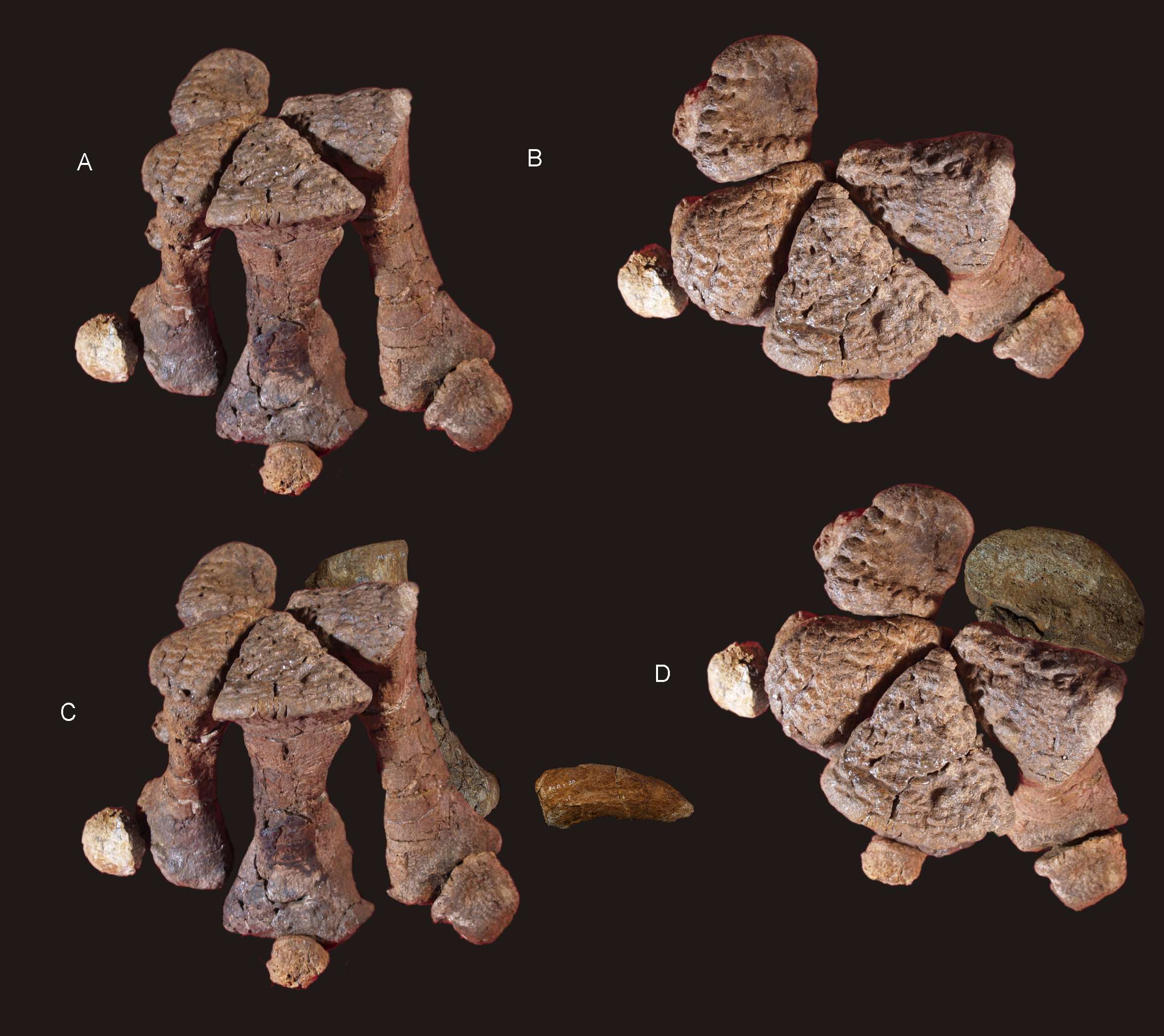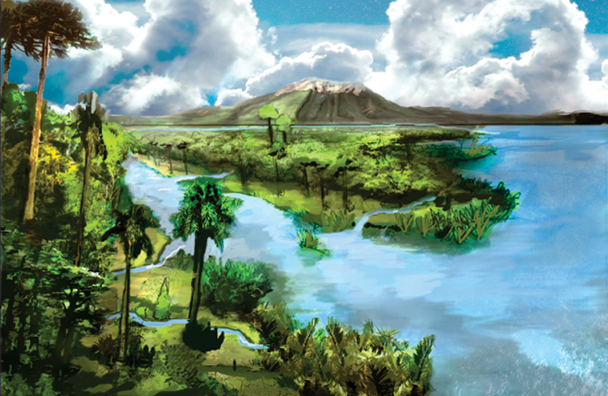|
Vahiny
''Vahiny'' (meaning "traveller" in Malagasy) is an extinct genus of titanosaur sauropod dinosaur known from the Late Cretaceous of the Maevarano Formation, northwestern Madagascar. It contains a single species, ''Vahiny depereti''. Description ''Vahiny'' was first described and named by Kristina Curry Rogers and Jeffrey A. Wilson in 2014 and the type species is ''Vahiny depereti''. It is known solely from the Late Cretaceous Maevarano Formation located in northwestern Madagascar, together with the more common titanosaur, ''Rapetosaurus krausei''. ''Rapetosaurus'' is the most common dinosaur in its fauna and is known from hundreds of bones, including multiple partial skeletons and skulls, while other taxa are extremely rare, including ''Vahiny'' identified from a partial braincase. ''Vahiny'' is distinguished from other titanosaurs by characteristics of its braincase, including the basal tubera, basipterygoid processes, parasphenoid, and cranial nerve foramina. Differences in th ... [...More Info...] [...Related Items...] OR: [Wikipedia] [Google] [Baidu] |
Maevarano Formation
The Maevarano Formation is a Late Cretaceous sedimentary rock formation found in the Mahajanga Province of northwestern Madagascar. It is most likely Maastrichtian in age, and records a seasonal, semiarid environment with rivers that had greatly varying discharges. Notable animal fossils recovered include the theropod dinosaur ''Majungasaurus'', the early bird ''Vorona'', the paravian ''Rahonavis'', the titanosaurian sauropod ''Rapetosaurus'', and the giant frog ''Beelzebufo''. Description The Maevarano Formation is well exposed in the Mahajanga Basin, in particular near the village of Berivotra near the northwestern coast of the island where its outcrops have been heavily dissected by erosion. At the time it was being deposited, its latitude was between 30°S and 25°S as Madagascar drifted northward after splitting from India about 88 million years ago. It is composed of three smaller units or members. The lowest is the Masorobe Member, which is usually reddish and is at least ... [...More Info...] [...Related Items...] OR: [Wikipedia] [Google] [Baidu] |
Pitekunsaurus
''Pitekunsaurus'' is a genus of titanosaurian sauropod dinosaur from the Late Cretaceous Anacleto Formation of Neuquén, Argentina. It was described by L. Filippi and A. Garrido in 2008. The type species is ''P. macayai''. The generic name is derived from Mapudungun ''pitekun'', meaning "to discover", the epitheton honours the discoverer, oil company explorer Luis Macaya, who found the fossil in April 2004. Classification ''Pitekunsaurus'' appears to be a genus of aeolosaurid, most closely related to the genera ''Gondwanatitan'' and ''Aeolosaurus''. Its braincase closely resembles that of the aeolosaurid ''Muyelensaurus'' as well as the titanosaurs ''incertae sedis'' '' Vahiny'' and ''Jainosaurus''. It cannot be compared to the more closely related ''Aeolosaurus'' and ''Gondwanatitan ''Gondwanatitan'' (meaning "giant from Gondwana") was a titanosaurian sauropod dinosaur. ''Gondwanatitan'' was found in Brazil, at the time part of the southern supercontinent Gondwana, in t ... [...More Info...] [...Related Items...] OR: [Wikipedia] [Google] [Baidu] |
Titanosaur
Titanosaurs (or titanosaurians; members of the group Titanosauria) were a diverse group of sauropod dinosaurs, including genera from all seven continents. The titanosaurs were the last surviving group of long-necked sauropods, with taxa still thriving at the time of the extinction event at the end of the Cretaceous. This group includes some of the largest land animals known to have ever existed, such as ''Patagotitan''—estimated at long with a weight of —and the comparably-sized ''Argentinosaurus'' and ''Puertasaurus'' from the same region. The group's name alludes to the mythological Titans of ancient Greek mythology, via the type genus (now considered a '' nomen dubium)'' ''Titanosaurus''. Together with the brachiosaurids and relatives, titanosaurs make up the larger sauropod clade Titanosauriformes. Titanosaurs have long been a poorly-known group, and the relationships between titanosaur species are still not well-understood. Description Titanosauria have the largest ... [...More Info...] [...Related Items...] OR: [Wikipedia] [Google] [Baidu] |
Titanosaurs
Titanosaurs (or titanosaurians; members of the group Titanosauria) were a diverse group of sauropod dinosaurs, including genera from all seven continents. The titanosaurs were the last surviving group of long-necked sauropods, with taxa still thriving at the time of the extinction event at the end of the Cretaceous. This group includes some of the largest land animals known to have ever existed, such as ''Patagotitan''—estimated at long with a weight of —and the comparably-sized ''Argentinosaurus'' and ''Puertasaurus'' from the same region. The group's name alludes to the mythological Titans of ancient Greek mythology, via the type genus (now considered a ''nomen dubium)'' ''Titanosaurus''. Together with the brachiosaurids and relatives, titanosaurs make up the larger sauropod clade Titanosauriformes. Titanosaurs have long been a poorly-known group, and the relationships between titanosaur species are still not well-understood. Description Titanosauria have the largest ran ... [...More Info...] [...Related Items...] OR: [Wikipedia] [Google] [Baidu] |
Maastrichtian
The Maastrichtian () is, in the ICS geologic timescale, the latest age (uppermost stage) of the Late Cretaceous Epoch or Upper Cretaceous Series, the Cretaceous Period or System, and of the Mesozoic Era or Erathem. It spanned the interval from . The Maastrichtian was preceded by the Campanian and succeeded by the Danian (part of the Paleogene and Paleocene). The Cretaceous–Paleogene extinction event (formerly known as the Cretaceous–Tertiary extinction event) occurred at the end of this age. In this mass extinction, many commonly recognized groups such as non-avian dinosaurs, plesiosaurs and mosasaurs, as well as many other lesser-known groups, died out. The cause of the extinction is most commonly linked to an asteroid about wide colliding with Earth, ending the Cretaceous. Stratigraphic definitions Definition The Maastrichtian was introduced into scientific literature by Belgian geologist André Hubert Dumont in 1849, after studying rock strata of the Chalk Group c ... [...More Info...] [...Related Items...] OR: [Wikipedia] [Google] [Baidu] |
India
India, officially the Republic of India (Hindi: ), is a country in South Asia. It is the seventh-largest country by area, the second-most populous country, and the most populous democracy in the world. Bounded by the Indian Ocean on the south, the Arabian Sea on the southwest, and the Bay of Bengal on the southeast, it shares land borders with Pakistan to the west; China, Nepal, and Bhutan to the north; and Bangladesh and Myanmar to the east. In the Indian Ocean, India is in the vicinity of Sri Lanka and the Maldives; its Andaman and Nicobar Islands share a maritime border with Thailand, Myanmar, and Indonesia. Modern humans arrived on the Indian subcontinent from Africa no later than 55,000 years ago., "Y-Chromosome and Mt-DNA data support the colonization of South Asia by modern humans originating in Africa. ... Coalescence dates for most non-European populations average to between 73–55 ka.", "Modern human beings—''Homo sapiens''—originated in Africa. Then, int ... [...More Info...] [...Related Items...] OR: [Wikipedia] [Google] [Baidu] |
Fossils Of Madagascar
A fossil (from Classical Latin , ) is any preserved remains, impression, or trace of any once-living thing from a past geological age. Examples include bones, shells, exoskeletons, stone imprints of animals or microbes, objects preserved in amber, hair, petrified wood and DNA remnants. The totality of fossils is known as the ''fossil record''. Paleontology is the study of fossils: their age, method of formation, and evolutionary significance. Specimens are usually considered to be fossils if they are over 10,000 years old. The oldest fossils are around 3.48 billion years old to 4.1 billion years old. Early edition, published online before print. The observation in the 19th century that certain fossils were associated with certain rock strata led to the recognition of a geological timescale and the relative ages of different fossils. The development of radiometric dating techniques in the early 20th century allowed scientists to quantitatively measure the absol ... [...More Info...] [...Related Items...] OR: [Wikipedia] [Google] [Baidu] |
Maastrichtian Life
The Maastrichtian () is, in the ICS geologic timescale, the latest age (uppermost stage) of the Late Cretaceous Epoch or Upper Cretaceous Series, the Cretaceous Period or System, and of the Mesozoic Era or Erathem. It spanned the interval from . The Maastrichtian was preceded by the Campanian and succeeded by the Danian (part of the Paleogene and Paleocene). The Cretaceous–Paleogene extinction event (formerly known as the Cretaceous–Tertiary extinction event) occurred at the end of this age. In this mass extinction, many commonly recognized groups such as non-avian dinosaurs, plesiosaurs and mosasaurs, as well as many other lesser-known groups, died out. The cause of the extinction is most commonly linked to an asteroid about wide colliding with Earth, ending the Cretaceous. Stratigraphic definitions Definition The Maastrichtian was introduced into scientific literature by Belgian geologist André Hubert Dumont in 1849, after studying rock strata of the Chalk Gr ... [...More Info...] [...Related Items...] OR: [Wikipedia] [Google] [Baidu] |
Cretaceous Madagascar
The Cretaceous ( ) is a geological period that lasted from about 145 to 66 million years ago (Mya). It is the third and final period of the Mesozoic Era, as well as the longest. At around 79 million years, it is the longest geological period of the entire Phanerozoic. The name is derived from the Latin ''creta'', "chalk", which is abundant in the latter half of the period. It is usually abbreviated K, for its German translation ''Kreide''. The Cretaceous was a period with a relatively warm climate, resulting in high eustatic sea levels that created numerous shallow inland seas. These oceans and seas were populated with now-extinct marine reptiles, ammonites, and rudists, while dinosaurs continued to dominate on land. The world was ice free, and forests extended to the poles. During this time, new groups of mammals and birds appeared. During the Early Cretaceous, flowering plants appeared and began to rapidly diversify, becoming the dominant group of plants across the Earth by the ... [...More Info...] [...Related Items...] OR: [Wikipedia] [Google] [Baidu] |
Dinosaurs Of India And Madagascar
Dinosaurs are a diverse group of reptiles of the clade Dinosauria. They first appeared during the Triassic period, between 243 and 233.23 million years ago (mya), although the exact origin and timing of the evolution of dinosaurs is the subject of active research. They became the dominant terrestrial vertebrates after the Triassic–Jurassic extinction event 201.3 mya; their dominance continued throughout the Jurassic and Cretaceous periods. The fossil record shows that birds are feathered dinosaurs, having evolved from earlier theropods during the Late Jurassic epoch, and are the only dinosaur lineage known to have survived the Cretaceous–Paleogene extinction event approximately 66 mya. Dinosaurs can therefore be divided into avian dinosaurs—birds—and the extinct non-avian dinosaurs, which are all dinosaurs other than birds. Dinosaurs are varied from taxonomic, morphological and ecological standpoints. Birds, at over 10,700 living species, are among the ... [...More Info...] [...Related Items...] OR: [Wikipedia] [Google] [Baidu] |
Late Cretaceous Dinosaurs
Late may refer to: * LATE, an acronym which could stand for: ** Limbic-predominant age-related TDP-43 encephalopathy, a proposed form of dementia ** Local-authority trading enterprise, a New Zealand business law ** Local average treatment effect, a concept in econometrics Music * ''Late'' (album), a 2000 album by The 77s * Late!, a pseudonym used by Dave Grohl on his ''Pocketwatch'' album * Late (rapper), an underground rapper from Wolverhampton * "Late" (song), a song by Blue Angel * "Late", a song by Kanye West from ''Late Registration'' Other * Late (Tonga), an uninhabited volcanic island southwest of Vavau in the kingdom of Tonga * "Late" (''The Handmaid's Tale''), a television episode * LaTe, Oy Laivateollisuus Ab, a defunct shipbuilding company * Late may refer to a person who is Dead See also * * * ''Lates'', a genus of fish in the lates perch family * Later (other) * Tardiness * Tardiness (scheduling) In scheduling, tardiness is a measure of a delay in exe ... [...More Info...] [...Related Items...] OR: [Wikipedia] [Google] [Baidu] |







